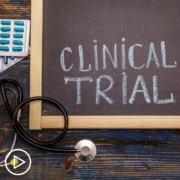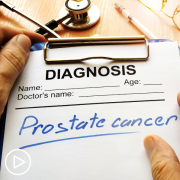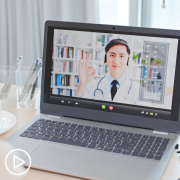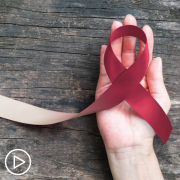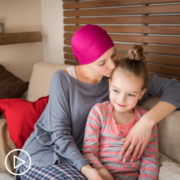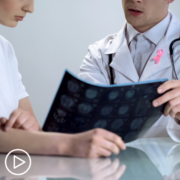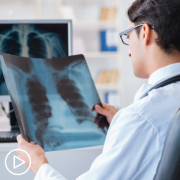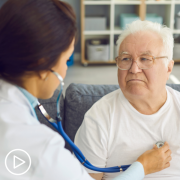Which Lung Cancer Treatment Is Right for You? What You Need to Know from Patient Empowerment Network on Vimeo.
What do you need to know before deciding which treatment is best for YOUR lung cancer? Lung cancer specialist Dr. Heather Wakelee reviews key factors that help guide treatment decisions, including biomarker testing, and shares advice for partnering with your team to advocate for the best care.
Dr. Heather Wakelee is a thoracic medical oncologist and deputy director of the Stanford Cancer Institute where she also serves as the division chief of medical oncology. Learn more about Dr. Wakelee, here.
This program is brought to you by the Patient Empowerment Network. It is made possible through support from Daiichi Sankyo, Foundation Medicine, Illumina, Merck, Novartis, and generous donations from people like you.
See More From INSIST! Lung Cancer
Download Guide
Related Programs:
Transcript:
Katherine:
Hello, and welcome. I’m Katherine Banwell, your host for you today’s program. Today, we’re going to discuss how to access the most personalized lung cancer therapy for your individual disease and why patients should insist on essential testing. Before we get into the discussion, please remember that this program is not a substitute for seeking medical advice. Please refer to your healthcare team about what might be best for you.
Let’s meet our guest today. Joining me is Dr. Heather Wakelee. Dr. Wakelee, would you please introduce yourself?
Dr. Wakelee:
Sure. Thank you so much and I’m really delighted to be on this and get to address all of our listeners. So, I am Dr. Heather Wakelee and I am a lung cancer specialist. I work at Stanford University where I’m also the chief of the Division of Medical Oncology.
Katherine:
Excellent. Thank you. Before we get into an in-depth discussion on lung cancer treatment, we’ve been hearing the term “personalized medicine” a lot more often. How would you define that term?
Dr. Wakelee:
That’s a great question. So, I think back when I first started taking care of patients living with lung cancer 20 years ago, we really just had chemotherapy for those with metastatic disease. And for those with earlier stage disease, it was just surgery radiation. And since that time, we’ve learned a whole lot and brought in a lot of different types of treatment. Surgery and radiation still have important roles for many patients.
And we think about them as being targeted and personalized based on stage, but it’s a little bit different. When we talk about personalized, we’re thinking more about what are aspects about the tumor that allow us to pick the right systemic treatment. So, “systemic” meaning a pill or something that we give IV.
With chemotherapy, we don’t have much to pick between them as far as specifics for the tumor. We can look at what we call the histology, which is how it looks under the microscope, whether it’s the squamous type or the non-squamous type and some of the chemotherapy drugs matter there. But, in the last 15, 20 years, we’ve learned about the specific what we call “gene mutations” that define the tumor.
And, depending on the gene mutation in the tumor, for some patients, we can give them pill therapy drugs that will work well. So, that’s personalized. Or, immune therapy now is an option for a lot of patients. That’s usually IV therapy.
And, there are some aspects of the tumor that can help us pick that also.
Katherine:
Well, I imagine that much of personalized immunotherapy for a patient requires a number of tests and then a thorough review of the results. So, can you provide an overview of important tests following a lung cancer diagnosis?
Dr. Wakelee:
That’s a fabulous question. When we think about the tests that we need to have done, they’re mostly tests that are done on the tumor, so, either if someone has a surgery or at the time of biopsy. and, that’s where we can figure out what we call, again, the histology that’s squamous or non-squamous. That’s when they look at it under the microscope. But, they also, with the tumor specimen, you can pull the DNA out of the tumor and then test for the gene mutations in the tumor. And, I always emphasize these are not changes in the genes that are in the whole person. They are things that are unique to the tumor. They are what make the tumor different from the rest of the person.
So, we look at those gene mutations or that’s kind of a biomarker. So, there are a lot of terms that we use, and I know it gets really confusing. So, I try to use “biomarker” to mean all of these things, but that gene mutation is what we look at in the tumor tissue to see if there are specific changes that will allow us to give a pill therapy, a targeted pill therapy. And then, there are also aspects of the tumor that help us figure out whether or not the immune therapy might work, and most commonly, that’s something called PD-L1. That’s a protein that we look at on the surface of the tumor, and so again, under the microscope.
Katherine:
And, when you talk about extracting DNA, is that via a blood test?
Dr. Wakelee:
So, we have two different ways to do that. So, what I was talking about before was from the tumor tissue, you can extract the DNA. But now, there are these liquid biopsies where we can draw blood and find the tumor DNA that is different from the rest of the person’s DNA and look for those gene mutations in the tumor.
And that is where there’s a lot of developments happening. And, that’s so fabulous because they’re often faster results for patients, and it means that you can not have to go through another biopsy. We still need the biopsy to establish whether or not there is even cancer. But, once we know that there’s cancer for sure, then we can use the liquid biopsies to get a faster information result on those gene mutations and to follow over time to see how the tumor evolves because tumors change after they’ve been treated.
Katherine:
Do you use imaging at all?
Dr. Wakelee:
Yes. Always. So, when someone is first diagnosed with cancer, we usually find that because of imaging, so, a CT scan or an X-ray, maybe they had a screening CT scan or maybe they had a cough that led someone to go get an X-ray, an examination. So, the imaging is a part of the original diagnosis. And in addition to CT scans, we’ll often get a PET scan that helps us look for, in a different way, the rest of the body, maybe an MRI of the brain to look in that area.
And then, wherever we’ve found the tumor, we will track that area with scans over time. And, it gets a little complicated for a patient that was found with what we call early-stage disease. So, stage I or II. Many of the times, those patients can have surgery and then we don’t have any tumor we can follow anymore. But we get CT scans to look to see if it could have come back. For patients with more advanced disease, so, stage III that couldn’t have surgery or stage IV, there we have areas that we’re going to continue to follow with the scans. And which scans and how often is going to depend a lot on what treatment the patient’s on and where the tumors are located that we’re tracking.
Katherine:
Do these tests differ for small cell lung cancer and non-small cell lung cancer patients? And, I know that non-small cell lung cancer is also known as NSCLC.
Dr. Wakelee:
Yes. So, long ago, the only distinction we had with lung cancer was that small cell versus non-small cell, and that is something that is seen under the microscope when that tissue is taken out from the biopsy. The pathology doctors look at it under the microscope, and the cells look different. And, the small cell lung cancer, those cells are small. It’s not very creative naming. And then, everything else is non-small cell or NSCLC. So, it’s SCLC and NSCLC. So, that was one of the first distinctions.
And, it is still very important because the chemotherapy drugs that we use are slightly different. And, the genetic, those gene mutations, we see them in any cancer. That’s what makes a cancer different from the rest of the body. But in small cell lung cancer, the tumor mutations that we see are not things that we know how to target specifically. In non-small cell, there are targets that we can target specifically for some patients.
So, just there, it’s different in having the targeted pill drugs in non-small cell, not so much in small cell. With immune therapy, those newer immune therapy IV drugs, they can work in both small cell and non-small cell. But for small cell, the biomarkers, that PD-L1 level is not as important for helping us figure out who’s going to benefit. For non-small cell, with many of the drugs, it is important. So, there are differences there.
Katherine:
Well, let’s go a little deeper. And, you did mention some of this already, Dr. Wakelee, but what is genomic or biomarker testing?
Dr. Wakelee:
So, we are struggling with how to have one unifying way of describing it because it’s so complicated. So, to me, biomarker testing is any aspect of the tumor that helps us choose the best treatment for that patient. And so, it’s a very broad term. And, within biomarker testing, there are several different ways that we look at it.
So, one is to look at what proteins are on the cell’s surface. And, we do that by having stains that we use to stain the tissue. So again, complicated, but when a piece of tissue is taken out of the person, part of the tumor is removed. It’s sliced into little tiny slices, which are then put on glass slides that can be looked at under the microscope. And, that’s how the pathology doctors can look and see, “Ah, this looks like cancer,” or, “It doesn’t look like cancer.” When it does look like cancer, you can then put on stains, so basically, different colored antibodies that will light up if that particular protein is there. And so, that helps us figure out for sure that this started in the lung because there are specific proteins that are only found in lung. So, that’s one way we used it, and this is an older technology. But, we also can use that to look for how much of this PD-L1 protein is expressed. And so, that’s an important biomarker, but it’s not based on genomics, which is when we’re talking about the DNA.
Then, we have the genomic testing, and that’s when we’re looking at the genome of the tumor and how that genome is different. And, that’s that DNA or RNA testing. We talk about it with the next-gen sequencing. So, “sequencing,” any of those terms are all meaning we’re looking at some aspect of what makes the tumor genes and therefore the proteins made by the tumor different than the rest of the genes in the person.
And so, that testing, that genomic testing can be done on either the tumor specimen or that’s where we can do blood tests that will be able to pull out those bits of the DNA that are from the tumor versus from the person and help us figure out what’s going on with the cancer. So, when we talk about biomarkers, the whole picture, and when I’m talking with patients who are diagnosed with lung cancer, we talk about well, there’s chemotherapy treatment, which is good for almost everybody. There is targeted therapy.
Targeted therapy is usually based on those genomic tests, and the genomic tests can be done either on the tissue or on blood. But, they’re really important to have a full understanding of the tumors to do a comprehensive or next-gen sequencing analysis of the tumor or DNA. And then, you have the immune therapy where that PD-L1 biomarker is important. So, that’s the way I think about it, and the biomarkers are really critical for helping us figure out what’s the best path forward for any individual patient.
Katherine:
Let’s turn to treatment, Dr. Wakelee. On a basic level, what are the goals of treatment for lung cancer?
Dr. Wakelee:
So, with lung cancer, we’d love to cure everybody, that’s the ultimate goal, and do it in a way where people are able to continue living their life as they were before the cancer diagnosis. The ways that we do it, first of all, we’ve got to find the cancer, and that’s where screening is such an important aspect of things. If we can find the cancer at an earlier stage, we’re more likely to be able to cure someone.
So, what do I mean by “earlier stage?” Well, when a tumor first develops, usually, there is a single cell that develops a mutation, meaning a change in the gene, which gives that cell an advantage so it doesn’t die the way it’s supposed to. And then, it keeps growing, and dividing, and making new cells. And those over time get to a large enough size that they are the cancer. And given more time, those cancer cells start to spread into other parts of the body, usually first into what we call the lymph nodes, and from there then into other organs in the body. And this stage refers to health or how the cancer spread. So, the stage I cancer is still in that ball of cancer. Stage II means that it’s spread into some lymph nodes. Stage III is it spread into more lymph nodes, usually in the center part of the chest or mediastinum, and that’s where it starts to be much more difficult for the surgeons to be able to truly remove all of the cancer.
And then stage IV means that the cancer is not something that we’re going to be able to remove with surgery. It’s spread either within the lung to the lining of the lung or it has spread to other organs in the body. And so, when we talk about those stages that I, II, III, IV, it’s a bit more complicated than that. But, I think for most people, if they just think about it as stage I, just the cancer, stage II, lymph nodes and the lungs, stage III, lymph nodes in the center, and then stage IV, elsewhere, that’s a good way to kind of wrap your head around it.
And when we talk about stage I and II, that’s the truly early stage where we hope to be able to cure people with surgery. Surgery alone is enough for the majority of people with stage I cancer, and for maybe half, a little more than half of people with stage II. So, how can we be better than that? Well, that’s where there’s been a lot of new advances. So, adding chemotherapy after surgery can help a lot of stage II patients.
If the tumor genomic testing biomarkers shows that there’s a mutation called EGFR, we now know that there’s a pill drug that people can take that would prolong the time to when the cancer might come back. And then, just very recently, there was stated that that immune therapy drugs IV can also prolong time to when the cancer comes back and maybe improve cure if the tumor has that biomarker called PD-L1. So, that’s that early stage. So it’s, again, getting more and more complicated and emphasizing that you’ve got to understand the biomarkers of the tumor to know how to best help someone.
When we move to stage III, some have surgery, but when you can’t have surgery, then we do the chemotherapy and the radiation. That’s the key part of the treatment there. And, we also know that immune therapy can be really helpful for a lot of patients when it’s given after the chemo and radiation’s completed. And then for stage IV, I talked about that already, which is you’ve got to do the biomarkers to figure out the best treatments for some people starting with a targeted pill drug is the right thing if their tumor has those right gene mutations.
For other people, immune therapy alone might be an option if the PD-L1 level is very high and they don’t have one of those gene mutations in the tumor. And for a lot of people, chemotherapy or chemotherapy plus immunotherapy is the right strategy.
Katherine:
Would you help the audience understand the types of therapy for small cell lung cancer specifically?
Dr. Wakelee:
Yes. So, small cell still has the same kind of staging, but it’s a little bit more simple. We talk about extensive stage or limited stage. And what that has to do with is we rarely do surgery for small cell. It tends to have spread earlier. There are a few cases where that’s done, but normally, we divide it up into limited or extensive. And when we talk about that, limited is the radiation doctors can get all of the cancer in one radiation field, and then radiation plus chemotherapy is the standard approach to try to cure. If it’s more extensive than that, then it becomes extensive stage.
And, the best treatment are going to be chemotherapy plus those immune therapy drugs added together.
And so, the chemotherapy drugs that we use for non-small cell and small cell, the platinum drugs play a role in all of it. The drug we partner is a little bit different. There’s a drug etoposide we use a lot in small cell and a lot of other options for non-small cell. And then, the immune therapy drugs, there are a lot of options that are fairly similar for both small cell and for non-small cell.
Katherine:
Dr. Wakelee, you mentioned targeted therapies. How do they work?
Dr. Wakelee:
Targeted therapies are something we can use when we find a specific gene mutation in the tumor. So, I mentioned before that in order for a cancer cell to become cancer, something has to happen to the DNA in the cell.
And, there’s a change or a mutation in the DNA of the cell which leads it to be a cancer. And, a lot of the time, that mutation happens in a specific kind of gene that makes a type of protein called a tyrosine kinase. And for those of you who haven’t studied a lot of science, it’s a word you might not have heard before. But basically, these tyrosine kinases are proteins in the body that make a lot of changes to what’s going on in the rest of the cell. So, they’re sort of what we call regulators. And, one way of thinking about them is like on and off switches. So, normally, their job is to sit and if the right molecule comes around, that turns it on, and then it turns on other proteins in the cell. And if that molecule isn’t there, it’s turned off. So, it’s this on and off switch that does a lot of other aspects of what’s going on in the cell. But, sometimes, a mutation happens. It turns it on all the time. So, it’s like if you leave the light on.
It’s on all the time, that’s using a lot of energy, and that’s actually what’s driving the cell to act like a cancer. And so, we can now look for some of those mutations that turn some of these tyrosine kinases on all the time. But, we’ve also developed drugs that we can use to turn them off. So, if we find this specific gene mutation that’s turning, say, the EGFR protein on all the time, if we find that, we can have the patient take a pill that then turns that off.
And that helps the cancer slow down, some of it die, some of the cancer cells die, but it doesn’t completely wipe it out. It helps the patient for a long time though by shrinking the cancer, helping them feel better because the symptoms are gone, keeping the cancer from growing. But, cancer cells are clever. They continue to divide, they can continue to make new mutations, and eventually, they figure out ways around that. So, when we talk about targeted therapy, it’s a setting where we find the cancer.
In the cancer, we find the gene mutation, it’s in one of these specific types of proteins, genes that make specific protein that turn something on that we can then turn off, and with those pill drugs, we can have a big impact for people.
Katherine:
And, what exactly is immunotherapy?
Dr. Wakelee:
Immunotherapies are treatments that were used to help keep the immune system more active.
So, the immune system is a very complex mechanism. There are cells that their whole job is to figure out and find things that are not us. So, they are looking for bacteria, they’re looking for cells that have a virus in them, and when they find it, they attack. And, that attack can be in the form of antibodies, it can be cells that actually go in and attack other cells directly, and we are all familiar a little bit with the immune system because we know that if we get a cold, our body, we can get a fever, that’s part of our immune response, and we get better. And then, some people know the bad side of the immune system if they have allergies or certain autoimmune diseases where the immune system gets a little bit too revved up and starts to recognize normal things as foreign.
So, in the setting of cancer, normally, the immune system is able to recognize a cancer cell, see that it’s different from the rest, and get rid of it. But, cancer cells are clever and they figure out ways to evade the immune system. And, one of the ways they do this is they put a protein called PD-L1. So, PD-L1 is a protein that a lot of our normal cells use to say, “Just a normal cell. Ignore me.” And so, when an immune cell comes in and sees that, it gets turned off it goes away. So, what our immune therapies do is most of them are blocking that PD-L1 protein. And, when they do that, it’s sort of like taking away the stop sign. So, you’ve got a tumor using a stop sign to say, “Go away, immune cell,” you block it so the immune cells can’t see that stop sign, and so then it kills the cancer cell better. So, that’s how these drugs work, and that’s the immune therapy.
There are some other stop signs besides PD-1 and PD-L1, but that’s the most common. So, when we’re talking about immune therapy, it’s drugs that block that. So, they increase the ability for the immune cell to recognize cancers. The risk from them is that you can get the body to recognize normal tissue as a problem sometimes. So, that’s the toxicity that we watch for.
Katherine:
Right. What are the advantages of these new treatment approaches compared to standard chemotherapy?
Dr. Wakelee:
Well, I think the most exciting news that we’ve seen in lung cancer over the last few years is that we’re actually helping more people live longer. And the way that we’re doing that is through these newer treatments. So, when we can personalize treatment by recognizing that a person’s cancer has a specific gene mutation and we can give them the right targeted pill drug, we can help them live longer and feel better because those often have fewer side effects. Wish I could say they were curing the disease, but they’re helping people live longer.
And, that can be measured in years for some folks, which is fantastic. And then, with immune therapy, again, they’re not working for everybody, but they were for a large number of patients with lung cancer with non-small cell to help them live longer with their cancer controlled. And so, we’ve actually improved the overall survival rates for lung cancer with these new developments. Where we can make even more of an impact is also by finding more of the cancers earlier, and that’s where cancer screening is so important also. So, by having more choices, chemotherapy can still help a lot of people. Targeted therapies can help probably close to 20, 30, 40 percent of people with non-small cell lung cancer that’s the adenocarcinoma type. And then, the immune therapies can help other people living with lung cancer. Usually immune therapies don’t work on the same tumors the way the targeted pills work. So, you’re kind of getting at different groups of people with those different strategies. It’s not completely true, but it’s a kind of general principle about it.
Katherine:
What about side effects for some of these treatment choices?
Dr. Wakelee:
So, chemotherapy is one people fear the most, but I think it has a bit more of a bad reputation than it needs. A lot of the lung cancer therapies that are chemotherapy can be reasonably tolerated. I mean, I’m not signing up to go get chemotherapy just because. There definitely are side effects. The biggest one is people get fatigue, get really tired. Though, if they’re feeling horrible because of the cancer, a lot of times people feel dramatically better. But, tiredness, it can impact appetite a little bit, though cancer does that also. There can be nausea, vomiting, but we’re much better at controlling that with the newer drugs. Some cancer therapies cause hair loss, but a lot of our non-small cell lung cancer therapies don’t cause hair loss. So, there are a lot of options there you can talk about with your doctor. And then, when the blood counts are low, there can be risk for infection, low red blood cells with anemia.
So, there are a lot of different things. But in general, chemotherapy is better tolerated than people think it’s going to be because in the movies, they make it look horrendous.
With the pill therapies, again, lots of variability depending on the specific pill. Some of them cause rash. Some don’t. Some of them can cause some changes to the heart that we have to monitor with EKGs, electrocardiograms, some don’t. Some cause some changes to labs like for liver tests that we have to monitor. Some don’t. Some cause hair color changes. Some don’t. It’s always to gray, unfortunately.
So, there are a lot of different variations in what different treatments can do. And so, it’s just really important if your doctor is talking with you about starting one of the targeted pill drugs that you really ask what are the side effects I need to be watching for, what are the ones I need to know to call you about, and which are the ones I just know, “Okay, this is happening and it’s okay. It’s going to cause swelling in the ankles,” no, just a huge range of them. And then, with the immune therapy drugs, they tend to be mostly fatigue, just like with chemotherapy, though some people feel fine.
What we have to watch for is that they can cause what we call autoimmunity. So, it’s talking about the fact that the way they work is they help the immune system better recognize the cancer, and they do that by taking away one of the stop signals. But, that stop signal, the PD-1, PD-L1, that stop signal is also used by a lot of normal cells to tell the immune system to back off. So, when you remove it, when you block it, the immune system can get confused and start to attack normal cells. So, you can get a rash, people can end up with gut symptoms like diarrhea, they also can end up with it attacking the lungs and causing what we call a pneumonitis lung inflammation or brain symptoms, so, almost anything. Now, those are rare, and we can treat them with steroids. But, people need to be aware that if something new is happening, they need to alert their doctor. I think sometimes, there’s this false impression that immune therapy is completely safe, but, it’s not. And, all of the treatments that I’m talking about are designed to help people live better and live longer when they’re dealing with lung cancer, but they all also have risk.
And so, it’s just really important to have those discussions with the care team as you’re starting something new about what are the things I need to be watching for and to know how to reach people if you’ve got a new and concerning symptom, especially if you’re starting on something new.
Katherine:
That’s all really helpful information. Thank you, Dr. Wakelee. We have a question that we received from an audience member earlier. Jeff asks, “How do you know if your lung cancer treatment is working?”
Dr. Wakelee:
So, there are a lot of ways of knowing if treatment is helping. So, the one I rely on the most is, “Does the patient overall feel better?” That is difficult to say exactly how. Sometimes people are having breathing problems; they feel that that’s better. Sometimes their energy’s lower. They feel better. It can be vague. We also use scans. So, we tend to get scans, depending on the treatment we’re giving, every couple of months plus or minus, sometimes, every three months to help track what’s actually going on. But occasionally, there are discrepancies.
So, sometimes, the scan, is it better? Is it not better? Can’t really tell. And then, you’re always taking that, “How does the patient feel?” So, usually, if the scans are better, the patient feels better. It’s easy. Usually if the patient’s feeling worse and the scan looks worse, clear decision. Not a good one, but clearly, we need to do something different. But sometimes, you’re left, and especially this happens with the first scan because you get a scan, it takes a little while, you start the new treatment, then you get the next scan, how much of the changes happened before you started the new one and how much didn’t? So, these can be more challenging conversations, but generally if the patient’s feeling a little bit better, the scan’s unclear, we usually say, “You know, let’s give this treatment a little bit more time.” We also, I think your question was specifically around how do we tell if it’s working, but, you also often need to be thinking about, “Well, what’s it doing that’s negative to the person and is that potential, those side effects worth the benefits we are or are not seeing?”
So, it’s kind of all of those things together. It can be a bit complex.
Katherine:
What goes into the decision to change therapies if it becomes necessary?
Dr. Wakelee:
So, when we’re thinking about making a change, the way I always look at it is, is where we are today still okay or not? And, if it’s not, that would be because clearly the cancer’s growing or clearly the side effects are just not tolerable. Then, we decide together with the patient we need to do something different. And, when we think about what do we do next, we look at what have we’ve already done, did it work or not, if not, let’s do something more different. And so, let’s think about something that might be somewhat similar. When we’re dealing with targeted therapies, we have ways to try to figure out what changed in the tumor that made it now resistant or not working with that treatment. And so, with some of the pill drugs, there’s been a lot of research and understanding how does the tumor change that helps it evade, get away from, be resistant to whatever treatment you’re on.
And then, sometimes, we have other pill drugs that work in that particular setting, not always. With immune therapy, we’re trying to better understand why does the immune therapy stop working? Sometimes you can add back to it, like, you can add chemotherapy back to immune therapy alone or sometimes you can do radiation with immune therapy to get that response back. Or, add other combinations to it. So, that’s another thing that we’re working on. And then, like I said, if someone hasn’t ever had chemotherapy and the tumor’s become resistant, we’re going to be thinking a lot about chemo because that can play a role against so many different reasons that the cancer might not be responding to whatever treatments someone’s on. And then also, looking at how the patient’s feeling and doing, what their overall what we call “performance status, ” their sort of overall health, and how well do we feel with them that they’re going to be able to tolerate the next treatment because, you’re always having to weigh how much is this likely to help, and how might this harm in finding the right balance.
Katherine:
I’d be remiss if I did not bring up COVID-19, and, I’m sure a lot of patients are curious whether the vaccine is safe and effective.
Dr. Wakelee:
So, we do believe the vaccine is safe and effective for patients living with lung cancer, and really important to be protected as much as possible. I was part of a group of other physicians around the world looking at the impact of COVID-19 on patients living with lung cancer. And, we collaborated with a group of physicians, Rayna Garcina was the lead. She was living in northern Italy at the time of the first wave, and so, was really face-to-face with it early on when there was so much we didn’t know. And, she gathered a group of us to watch and see, and what we were able to figure out before the vaccine was available was that people living with lung cancer who were overall healthy still except for their cancer were perhaps on a pill, targeted therapy, or immune therapy seemed to really not have that different of an impact compared to people who didn’t have lung cancer.
Chemotherapy was a little bit harder to see that, but didn’t seem to be such a big issue. It’s different than people living with, say, leukemias or lymphomas where the treatments are impacting their immune systems even more. They seem to have worse outcomes. A lot of lung cancer patients were okay, but still, it’s a higher risk. And so, we want to protect our patients as much as possible.
So, we are, now that we have the vaccines, strongly advocating vaccines for any patient who was living with cancer really for almost anybody because as a physician, we really think that makes a big impact. We have not seen any negative impacts of the vaccine on any aspect of cancer treatment. It does not have a negative impact on how well the cancer is treated by the therapies. We did notice that when someone gets the vaccine, they can get some enlargement of the lymph nodes. That’s part of having an immune response is your lymph nodes get enlarged. And so, we did get a bunch of scans that the vaccines came out showing, “Well, this person has some lymph nodes in the axilla, which is the armpit.”
And it seemed to be correlating with the side that someone had a vaccine. And then, those go away. And, this was actually an interesting medical literature thing because for people getting screened with mammograms for breast cancer, there were suddenly all these lymph nodes showing up. But that was actually a sign that the person was responding to the vaccine and it went away over time. And, it was a fine thing. It was just – I remember the first patient I had where that happened, we’re like, “Oh, well, that makes sense. Okay.” So, it’s okay. So, it was not cancer. It was just the immune response. But, yeah, so, we are recommending vaccines. There’s no data showing it is not working for lung cancer patients. The vaccines are less effective in people getting certain types of cancer treatment that are really suppressing the immune system. But even some response is better than none, and we’re still recommending the patients really do their best to stay safe with masks and things like that.
Katherine:
Dr. Wakelee, what are you excited about in lung cancer research right now? And, what do you want to leave the audience with? Are you hopeful?
Dr. Wakelee:
I’m very hopeful. When I started treating lung cancer patients 20 years ago, we only had chemotherapy. And now, for metastatic disease, with using the right biomarkers, we can figure out so much more about the cancer to be able to personalize the treatment, for many patients, being able to offer pill therapies that are somewhat less toxic and highly active and give people more time. And now, we’re in the immune therapy revolution, which is helping a whole other group of patients living with lung cancer to be able to live with quality life for much longer. And the pace of discovery is just going up so quickly. And, I think that’s what I’m most hopeful about is just how much attention is being paid on lung cancer and finding better therapies that are going to help more people for a longer period of time. And again, I’m going to emphasize the screening is making a big difference also. If we can find the disease early, we can have an even bigger impact on people.
Katherine:
Dr. Wakelee, thank you so much for joining us today.
Dr. Wakelee:
Thank you. Really enjoyed talking with you. Thank you.
Katherine:
And thank you to all of our partners.
To learn more about lung cancer and to access tools to help you become a proactive patient, visit powerfulpatients.org. I’m Katherine Banwell. Thanks for joining us today.






